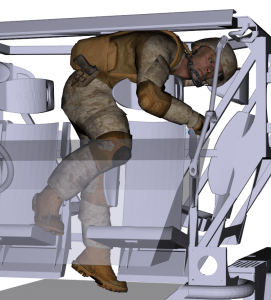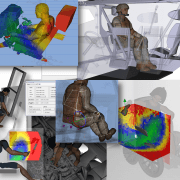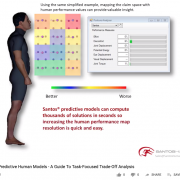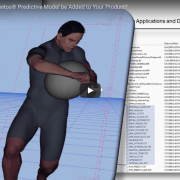Blog Series: Failing to Optimize the Human-in-the-Loop at the Earliest Stages of Design is More Expensive than You Think – 3 of 3
For those who have just arrived, welcome. Post #1 can be found here and post #2 can be found here. For everyone else, thank you for following this series and for coming back for the third and final post.
The opening statement in this series was that most design processes, whether intentional or not, effectively prioritize product capability over usability. The considerable cost of failing to prioritize usability was then shown through client engagement examples from four different industries.
All examples presented in the first two posts would have benefitted significantly if design teams had the ability to evaluate the human-in-the-loop in ways that could inform and support product development decisions. That has been the promise of digital human modeling for decades. Yet, examples just like those presented continue and they are not only common but pervasive throughout most industries.
This final post focuses on why and, of course, provides a solution.
The Problem
Most commercially available digital human models are really just virtual mannequins. Like the mannequins found in department stores, virtual mannequin joints must be individually rotated into place until some recognizable human activity is achieved. Manipulating mannequin joints within a computer environment is tedious, non-intuitive, time-consuming, and subjective. It can also be quite frustrating, not only because non-human-looking results are a frequent option, but also because every design change requires the entire process to be repeated.
Companies that provide virtual mannequins have worked hard to mitigate this frustration by including the ability to leverage pre-recorded snapshots of human activity, primarily in the form of motion capture data. Use of motion capture data to drive virtual mannequin postures does circumvent the need to interactively manipulate their joints but that data is also expensive to acquire and time-consuming to process. In fact, recent estimates from one of our automotive clients indicated an internal motion capture budget of over $30,000 per subject, per motion capture study.
But the real problem with using pre-recorded data of any kind in design is that it’s inflexible. It cannot respond to change. It can only be used as acquired. Any design change that potentially affects human interactivity requires the acquisition of more data. This is great news for companies in motion capture-related businesses, but it’s a nightmare for design teams and their budgets and deadlines. Unfortunately, this contributes to an even bigger problem.
Because virtual mannequin joints must either be manually manipulated or driven by pre-recorded data, they can really only react to an existing design. This means significant resources must first be expended to bring a design to a relatively high level of maturity before a virtual mannequin can be deployed. In other words, the use of a virtual mannequin requires a rather long list of traditional engineering efforts to be completed first. Consequently, at the point when human-centric evaluations can finally occur, any indicated need for change will be in direct conflict with all the resources already expended.

This is almost the same situation design teams were in before virtual mannequins existed; when product evaluations could only be accomplished through trial and error, physical prototypes, and focus groups. While the need for physical prototypes may be reduced, human-centric evaluations still occur too late to be effective. What is most ironic is that the usability of your products by your customers—those who ultimately determine your product’s success in the market—is effectively being treated as if it is among the least important of your product’s design criteria.
Why are outcomes like those presented in this series so common? Because traditional design processes do not allow human-in-the-loop evaluations to occur until late in a product’s development cycle when change is no longer a realistic option.
The Solution
To be clear, Santos® technologies offer significant advantages in these traditional workflows which appear to be pervasive throughout most industries. Santos® predictive models are fast, flexible, objective and of course, predictive. Because they’re predictive, they provide a fair amount of autonomy which makes them easier to use and easier to use correctly.
However, the real value of Santos® virtual human-in-the-loop solutions lies in the unique ability to predict human physical behavior and performance while taking into consideration the human-centric challenges we must all deal with every day in the physical world. These challenges include:
- Simultaneously achieving multiple and competing task goals
- Mitigating limitations in strength, flexibility, and fatigue
- Optimizing grasp strategies
- Ensuring we can see what we’re doing
- Remaining in balance and avoiding collisions in spite of external forces that may be acting upon us
- Trying not to get hurt
A truly predictive model makes trade-off analysis (the evaluation of what-if scenarios) possible. Trade-off analysis is why predictive models are created and why they are so valuable. A truly predictive human model can provide the task-focused trade-off analyses your teams need to optimize the human-in-the-loop at the earliest stages of design—where change is not only most effective but still an option.
Watch this video for one example of how this is done.
Conclusions
Like many of the companies we work with, your company has probably been in business for a very long time. Your teams probably have 100’s if not 1000’s of employee-years’ worth of experience using your existing design processes. And your revenues are likely in the millions if not billions of dollars per year. By all objective measures, your company is exceptionally good at what it does.
However, consider that your design teams Avoid the Cost and Uncertainty of Trial & Error in meeting:
- Structural Performance Requirements through the use of Finite Element Analysis
- Aerodynamic and Thermal Performance Requirements through the use of Computational Fluid Mechanics
- Mechanical System Performance Requirements through the use of Multi-Body Dynamics
So, why continue to incur the cost and uncertainty in meeting human-in-the-loop requirements through trial and error? Those humans-in-the-loop are your customers. Their positive feedback is that next level of competitive advantage.
SantosHuman Inc. When you need to get it right the first time.
Thank you for staying with the series, keep an eye on this space for new blog topics, and let us know what you think. We’d love to hear from you.
– S





